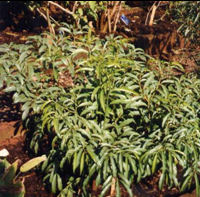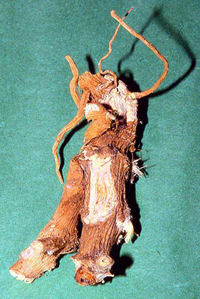Brazilian ginseng-Suma
Suma, also called Brazilian ginseng (Pfaffia paniculata) is the root of a shrubby ground vine which has an intricate and deep root system. The plant is indigenous to the rainforests of the Amazon basin, as well as other tropical parts of Brazil, Ecuador, Panama, Paraguay, Peru, and Venezuela.
The main constituents of Suma are the saponins, including pfaffic acid and six unique pfaffosides, which are divided into two groups. Pfaffosides A, B, and C are classified as nortriterpene gluconisides; and pfaffosides D, E, and F are nortriterpene saponins.
Suma Root contains 19 different amino acids, a large number of electrolytes, and trace minerals including iron, magnesium, cobalt, silica, zinc, and vitamins A, B1, B2, E, K, and pantothenic acid.
Introduction
Since its first botanical recording in 1826, Suma has been referred to by several botanical names, but most importantly Pfaffia paniculata. In South America Suma is known as para toda (which means "for all things") and as Brazilian ginseng, since it is widely used with many applications (much like "regular" ginseng).Brazilian Ginseng is well known in the South American culture. It is an herbal supplement that is beneficial to good mental pressure and effort, and it supports recovery and recuperate after illness. Suma hundreds of years was put long as female tonic, "it helps discomfort before / around / during menstruation. Now, it is becoming increasingly popular in the western world.

|
Photo: Brazilian ginseng is a plant with an elaborate root system. In addition to the roots, the shrub was originally used by native inhabitants of the rainforest as a wholesome herb. |

|
Photo: Suma has an extensive network of roots below the surface of the earth. The root can be ground and used as a wholesome herb. It can also be added as flavouring or used to make tea. |
Application
Brazilian ginseng can be taken in capsules, and as a tea beverage. It can also enhance the flavour of chicken soup. Suma root products are now becoming more widely available; several encapsulated, ground-root products, root extract powders and liquid extracts (decoctions) are out there.Brazilian ginseng is mostly used internally but it can be found in certain cosmetics, such as facial creams, moisturizers and shampoo.
Suma nourishes and protects the skin and makes rough skin soft and smooth.
It is not clear whether Brazilian Ginseng was already on the market and consumed to a significant degree before 15 May 1997 and whether it is therefore, according the EU Novel Food Regulation, allowed to be used as or in food supplements and as or in food. Other specific legislation, however, may restrict the placing of Brazilian Ginseng as a food or food ingredient on the market in some Member States.
The German Commission E Monographs, a therapeutic guide to herbal medicine, does not mention Brazilian Ginseng.
Brazilian Ginseng is also not mentioned in the EHIA Inventory List of Herbals that are considered to be Food.
Extracts of Pfaffia paniculata for use in cosmetics however, are as such mentioned for softening in EU Decision 96/335/EG from EU Cosmetic Directive 76/768/EEG and/or 2006/257/EG.
Beneficial for:
Brazilian ginseng is like regular ginseng an adaptogen, a plant that increases the resistance.The original inhabitants of the Amazon used Suma last 300 years: as an invigorating tonic for energy and protect against aging, as aphrodisiacs, as a natural sedative and for its stomach-reinforcing effect.
Brazilian ginseng is good for the blood vessels, is good for the nervous system and digestion.
Suma is good for increasing endurance, reduces sensitivity to stress, boosts the immune system and helps lower cholesterol.
Suma promotes the (natural) immune system of the body cells and protects against aging.
According to the Dutch Guidelines KOAG / KAG allowable terms, related to this product, are:
- Fortifying tonic for energy.
- Helps discomfort before / around / during menstruation.
- Helps in tiredness / fatigue.
- If aphrodisiacs.
- In order to reduce stress.
- Stimulation of the immune system.
- Natural tranquilizer.
So far, the European Food Safety Authority (EFSA) has not approved any of the submitted health claims for this product or its components, and these should therefore not be used in the EU.
Industrial application
Nothing is found that Brazilian Ginseng is used for any other purpose than as a food component or in cosmetics.Dosage
For high doses effects, dry Suma root is given at dosage of 5-10 grams per day preferably divided in 3 applications per day.As a food supplement Brazilian Ginseng is most often advised in dosage from 2 - 4 grams of dry root per day.
If a concentrated Suma extract powder (ratio = 10:1) is used, a dosage of 100-250 mg per day should should be sufficient.
For cosmetics, there is no established recommended dosage, although impact would have to increase as the dose is increased. For working Suma extract powder into cosmetics, most often an up to 1% concentration in the final cosmetic product is mostly added.
Contra-indications
There is no indication that Suma could be dangerous. No toxic effects are seen when used orally or topically.Be advised:
- In rare cases, the root powder might cause asthmatic allergic reactions if inhaled. Avoid inhalation of the root powder/dust.
- Ingestion of large amounts of plant saponins in general has shown to sometimes cause mild gastric disturbances including nausea and stomach cramping. Reduce dosages if these side effects are noted.
- Use cautiously in patients with hormone-sensitive conditions.
- Use cautiously in patients with heart conditions.
- Use cautiously in patients with gastrointestinal disorders, as ingestion may cause mild gastrointestinal disturbances, including nausea and stomach cramping.
- Avoid in patients with known allergy or sensitivity to suma, its constituents, or members of the Amaranthaceae family.
- There is currently a lack of available scientific evidence on the use of suma during pregnancy or breastfeeding.
- Suma may interact with antibiotics, anticancer agents, anti-inflammatory agents, cholesterol-lowering drugs, hormonal agents, or pain relievers.
Copyright © 2011 Benseng Foodsupplements BV, Veghel, The Netherlands. See: www.benseng.nl
 |
 |
| vorige | volgende |
